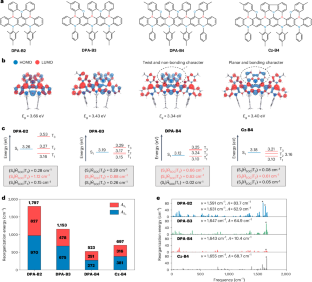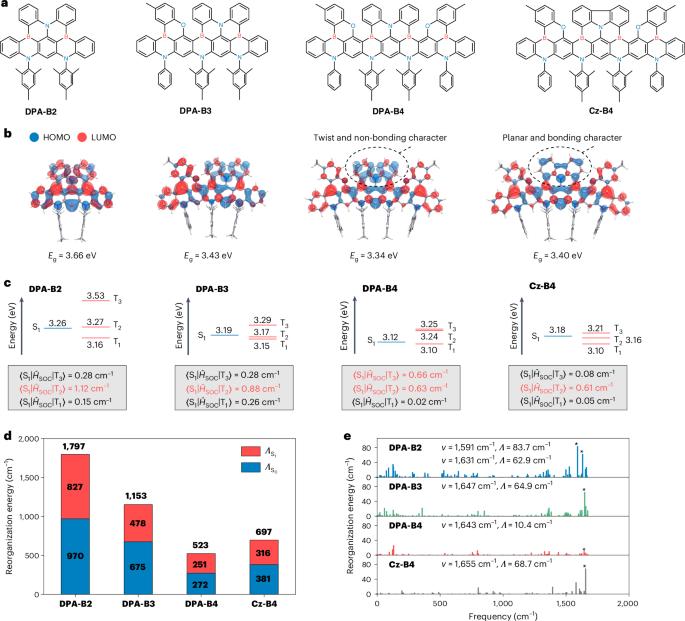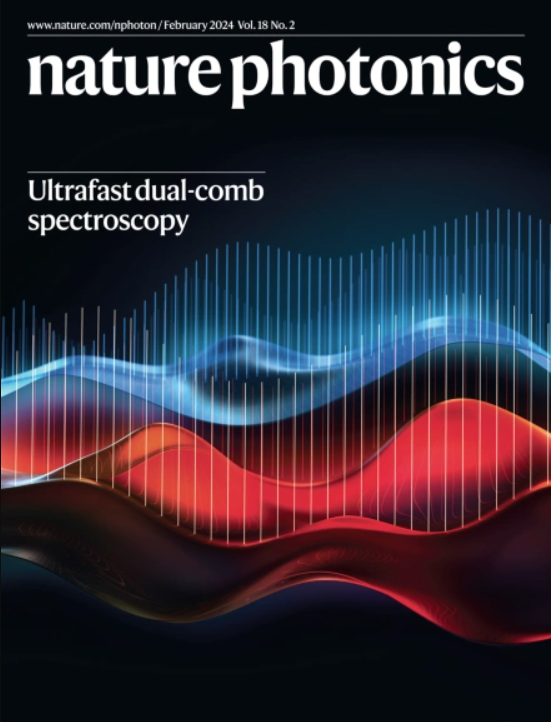Deep-blue organic light-emitting diodes for ultrahigh-definition displays
IF 32.3
1区 物理与天体物理
Q1 OPTICS
引用次数: 0
Abstract
Multiple-resonance thermally activated delayed fluorescence materials have emerged as promising candidates for next-generation ultrahigh-definition displays due to their narrowband emission and triplet-harvesting capability. However, achieving optimal colour purity and device efficiency for blue multiple-resonance thermally activated delayed fluorescence emitters has presented challenges. Here we demonstrate an effective approach to attain superior deep-blue molecules by constructing twisted-boron-/nitrogen-/oxygen-embedded higher-order fused-ring frameworks with fully resonating structures. The optimized emitter exhibits high rigidity and minimized bonding/antibonding character for ultrasharp emission, along with a small singlet–triplet gap and large spin–orbit couplings for rapid spin flip. This combination results in deep-blue emission at 458 nm with a narrow full-width at half-maximum of 12 nm in solution and a reverse intersystem crossing rate constant of 2.29 × 106 s−1, on par with those of heavy-atom-based multiple-resonance thermally activated delayed fluorescence molecules. The related single-unit organic light-emitting diode achieves an external quantum efficiency of 39.2% with colour coordinates of (0.141, 0.050) and a narrow full-width at half-maximum of 14 nm. Furthermore, a two-unit stacked tandem hyperfluorescence organic light-emitting diode achieves an ultrahigh external quantum efficiency of 74.5% with low efficiency roll-off at high luminance values. This performance represents a remarkable balance between efficiency and colour purity in the deep-blue region, marking an important step towards power-efficient ultrawide-colour-gamut displays. Highly twisted multi-boron-based multiple-resonance thermally activated delayed fluorescence emitters enable deep-blue organic light-emitting diodes with high colour purity, a narrow full-width at half-maximum of 14 nm and a peak external quantum efficiency of 39.2%.


用于超高清显示器的深蓝色有机发光二极管
多重共振热激活延迟荧光材料因其窄带发射和三重收集能力,已成为下一代超高清显示器的理想候选材料。然而,实现蓝色多重共振热激活延迟荧光发射器的最佳色彩纯度和器件效率一直是个难题。在此,我们展示了一种有效的方法,即通过构建具有完全共振结构的扭曲硼/氮/氧嵌入式高阶熔环框架来实现卓越的深蓝色分子。优化后的发射体具有高刚性和最小化的键合/反键特性,可实现超锐利发射,同时还具有较小的单线-三线间隙和较大的自旋轨道耦合,可实现快速自旋翻转。这种组合可产生 458 纳米波长的深蓝色发射,在溶液中的半最大窄全宽为 12 纳米,反向系统间交叉速率常数为 2.29 × 106 s-1,与基于重原子的多共振热激活延迟荧光分子的速率常数相当。相关的单单元有机发光二极管的外部量子效率为 39.2%,色坐标为(0.141,0.050),半最大窄全宽为 14 纳米。此外,双单元叠加串联超荧光有机发光二极管的外部量子效率达到 74.5%,而且在高亮度值下效率衰减较低。这一性能在深蓝区域的效率和色彩纯度之间实现了出色的平衡,标志着向高能效超高色彩-高亮度显示器迈出了重要一步。
本文章由计算机程序翻译,如有差异,请以英文原文为准。
求助全文
约1分钟内获得全文
求助全文
来源期刊

Nature Photonics
物理-光学
CiteScore
54.20
自引率
1.70%
发文量
158
审稿时长
12 months
期刊介绍:
Nature Photonics is a monthly journal dedicated to the scientific study and application of light, known as Photonics. It publishes top-quality, peer-reviewed research across all areas of light generation, manipulation, and detection.
The journal encompasses research into the fundamental properties of light and its interactions with matter, as well as the latest developments in optoelectronic devices and emerging photonics applications. Topics covered include lasers, LEDs, imaging, detectors, optoelectronic devices, quantum optics, biophotonics, optical data storage, spectroscopy, fiber optics, solar energy, displays, terahertz technology, nonlinear optics, plasmonics, nanophotonics, and X-rays.
In addition to research papers and review articles summarizing scientific findings in optoelectronics, Nature Photonics also features News and Views pieces and research highlights. It uniquely includes articles on the business aspects of the industry, such as technology commercialization and market analysis, offering a comprehensive perspective on the field.
 求助内容:
求助内容: 应助结果提醒方式:
应助结果提醒方式:


